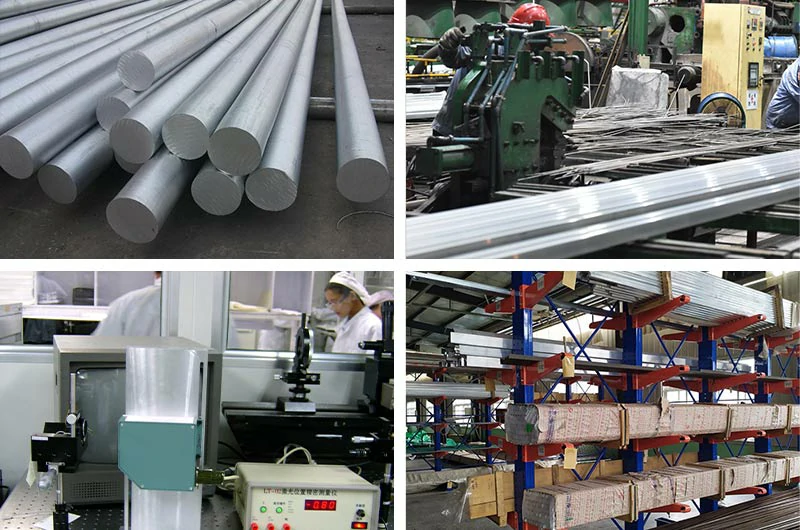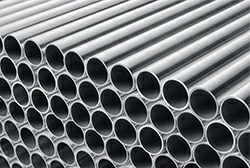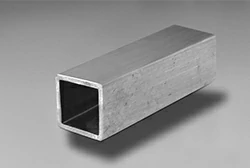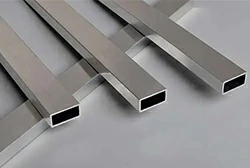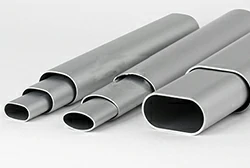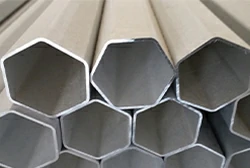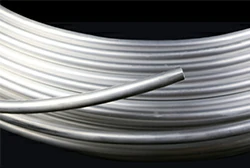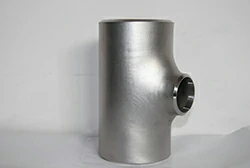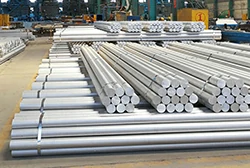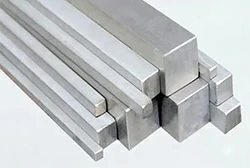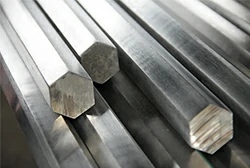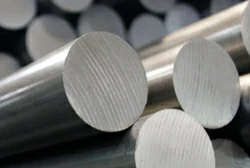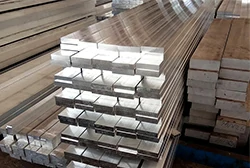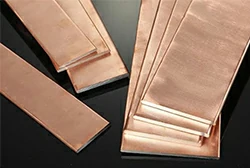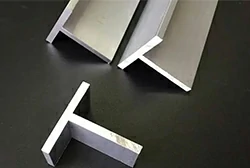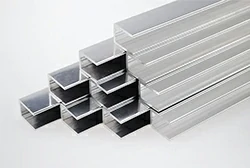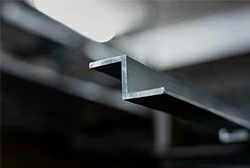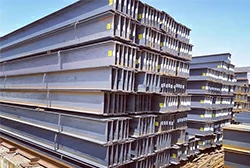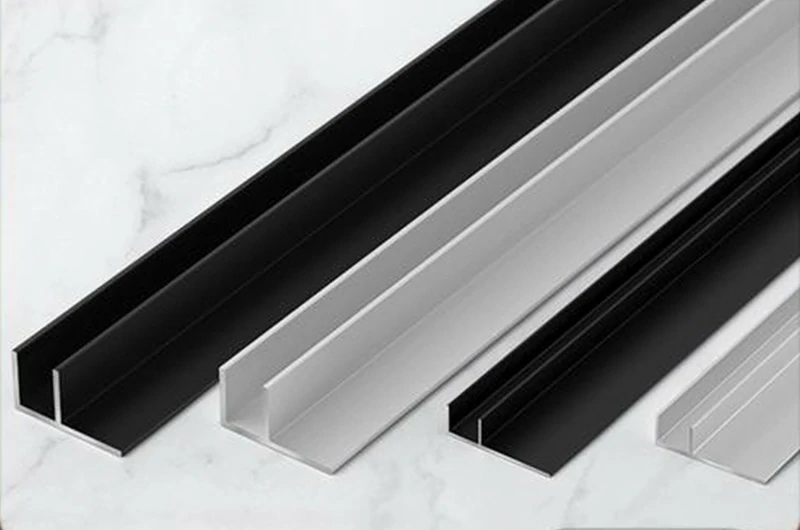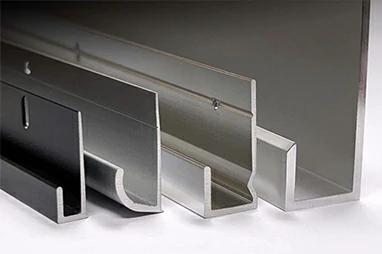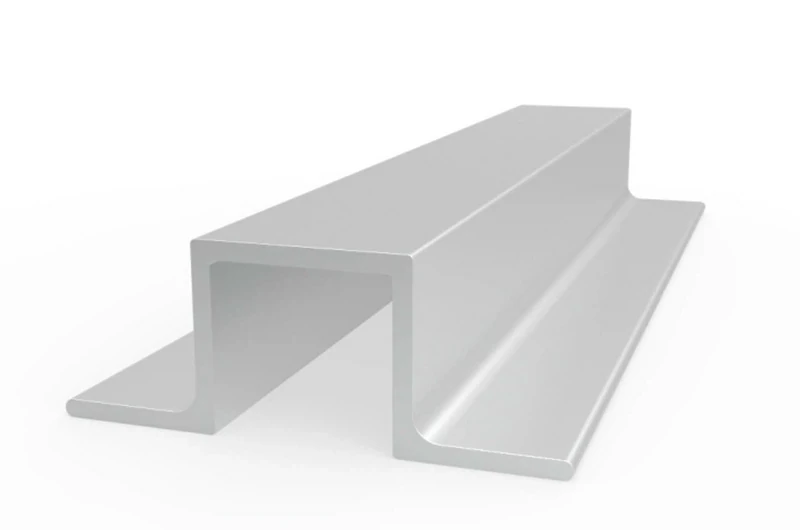Aluminum profiles make full use of the excellent ductility of aluminum. Aluminum products with specific shapes and sizes are formed through extrusion, stretching, die-casting and other processing processes. They have the advantages of light weight, high strength, corrosion resistance and other advantages.
Standard hollow aluminum profile
Usually, hollow standard aluminum alloy profiles are in tubular shape. These aluminum tube products can have different cross-sectional shapes, such as square tubes, round tubes, rectangular tubes, etc. These profiles typically adhere to international or national standards like ASTM, EN, etc., ensuring their quality and dimensional consistency.
Hollow profiles are generally lighter because they are hollow inside, making them more suitable where structural loads need to be reduced or where a lightweight design is required. In addition, the space inside the hollow profile can also be used to hide wires, pipes and other facilities, improving the overall aesthetics.Quick Quote
- Aluminum round tube
- Aluminum square tube
- Aluminum rectangular tube
- Oval flat hollow tube
- Aluminum hexagonal tube
- Aluminum coil tube
- High frequency welded pipe
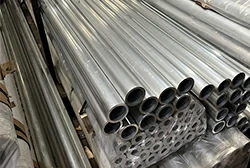
- Anodized aluminum tube
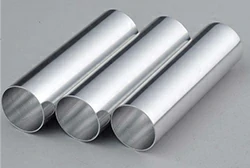
- Aluminum pipe-tee
Standard solid aluminum profile
Solid aluminum alloy profiles are profiles made of aluminum alloy and there is no hollow structure inside the cross-section, typically in the form of solid aluminum bar rods. Common shapes of solid aluminum alloy profiles include square profiles, round profiles, angle profiles, etc. Their size and shape can be customized according to specific engineering requirements.
This type of profile usually has higher strength and stiffness and is suitable for applications that need to withstand greater pressure or require greater stability, such as structural support that needs to withstand greater pressure or for high loads.Quick Quote
Special aluminum profiles
A specialty profile is a metal material with a specific design or shape, often used for special engineering and manufacturing needs. Common special profiles include SD aluminum profiles, RCW profiles, variable cross-section profiles, micro-channel profiles, radiator profiles and other customized size profiles. They come in a variety of cross-sectional shapes and cross-sectional sizes.Quick Quote
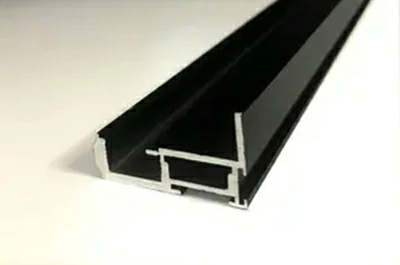 SD aluminum profile (Semi-enclosed profile)
SD aluminum profile (Semi-enclosed profile)- Commonly used in construction for frames, walls, and handrails, its semi-closed design enhances strength, stability, and installation ease.
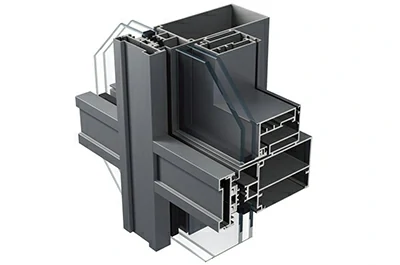 RCW profile (Reinforced Curtain Wall)
RCW profile (Reinforced Curtain Wall)- Mainly used in building curtain wall systems for reinforcement. RCW profiles offer increased structural stability and wind pressure resistance, perfect for high-rise and complex buildings.
 Variable section profiles
Variable section profiles- Frequently used in engineering for customizable shapes, perfect for diverse construction and machinery applications, offering flexibility and creativity for designers and engineers.
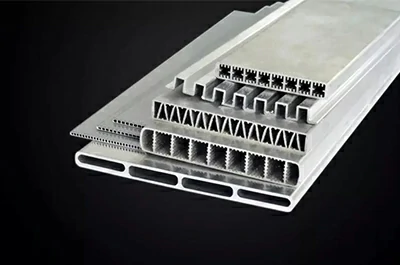 Microchannel profiles
Microchannel profiles- Micro-channel profiles, used in automotive engines and AC systems, enhance heat conduction, lowering engine temps and improving cooling and refrigeration.
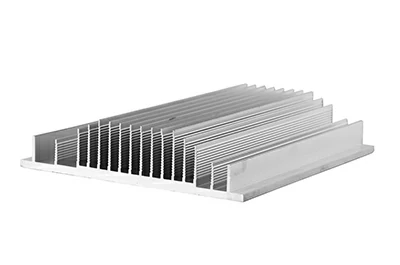 Heat sink aluminum profile
Heat sink aluminum profile- Radiator profiles are metal profiles used in radiator manufacturing. They efficiently dissipate heat, maintaining stable equipment temperatures in various working conditions and environments.
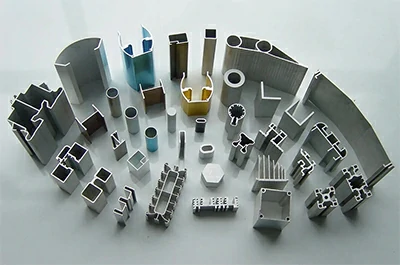 Other customized profiles
Other customized profiles- We also provide customization services for other special sizes and shapes. Welcome to contact us for consultation.
T - slot profile
T-slot profile is an aluminum profile with a "T"-shaped cross section and one or more T-slots on the top. These slots can be used to install bolts, nuts and other accessories, making them ideal for building a variety of structures and frames.
T-slot profiles are commonly used in machinery supports, automation equipment, workbenches and other industrial applications. Their design is modular and flexible, making the construction and adjustment process easier and more efficient.Quick Quote
- 15*15
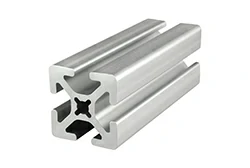
- 20*20

- 20*40
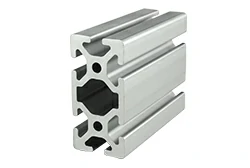
- 30*30

- 40*40

- 40*80

- 50*100

- 60*60

- 80*80

Key quality indicators of aluminum profiles
1. Appearance quality requirements: there are no defects such as electric burns or oxide film peeling on the surface of anodized materials; the paint film is uniform, clean and smooth, without wrinkles, cracks, bubbles, flowing, inclusions and peeling marks; aluminum alloy building profile coating treatment, Avoid scratches, collisions and corrosion.
2. Wall thickness: the wall thickness of the profile is one of the main factors affecting the strength of the workpiece. The main section is the stressed part of the project. For example, the minimum nominal wall thickness of the main profile of an exterior window should not be less than 1.4mm.
3. Film thickness requirements: the surface of extruded aluminum alloy profiles is not very corrosion-resistant and needs to be treated to increase corrosion resistance, wear resistance and aesthetics. The thickness of the anodized aluminum film is divided into AA10, AA15, AA20 and AA25; the thickness of the electrophoretic coating aluminum film is divided into ABS, the minimum local thickness of powder spraying is more than 40um, and fluorocarbon spraying has different requirements for layer thickness.
4. Chemical composition and mechanical properties: the chemical composition and mechanical properties of aluminum alloy profiles vary, and customers should check them one by one according to the standards (contract terms).
5. Color difference: there are differences in color brands and supply status. It is recommended that the impact of color difference on the building structure should be considered when selecting the alloy plate number and supply status.
6. Resistance to salt spray corrosion, wear, waiting and mortar, etc.: this is an important technical parameter of aluminum alloy profiles. It reflects the performance of aluminum alloy profiles and affects its use.
Aluminum profile alloy selection
| Alloy series | Typical alloys | Feature | Application areas |
| 1000 | 1050 1070 1100 1197 | Pure aluminum soft Non-heat treatable Good thermal conductivity | Heat transfer Automotive HVAC/R Industry Electrical industry |
| 3000 | 3102 3103 3003 | Good corrosion resistance Non-heat treatable medium intensity Good processability 3003 is 20% stronger than 1100 | Building applications Gutters, Downspouts, Roofing and Siding Automotive HVAC/R Industry Outdoor application Other anti-rust applications |
| 5000 | 5083 | More weldable than 6000 Excellent corrosion resistance | Marine ship structure applications |
| 6000 | 6061 | High corrosion resistance Heat treatable alloy Weldable Magnesium silicon Good weldability and formability | Building materials Car parts Ship parts Bridge components |
| 6063 | High corrosion resistance Good processability and weldability Anodized for best appearance Finer grain structure than 6061 | Railway vehicle components Pipes/piping Electrical bus conductors Building applications | |
| 6082 | High corrosion resistance Good appearance after anodizing High strength | Truck body Floor | |
| 7000 | 7075 | Contains more zinc than 6061 High strength | High intensity applications Aerospace Military equipment |
| 7108 | High strength Limited extrudability and formability | Construction and transportation applications |
Advantages of aluminum profiles
- It has a lower density than other common metals and is lightweight.
- Hot and cold processes are used in the production process, which has strong corrosion resistance.
- It has good ductility and can be used to make light alloys with a variety of metal elements. It is made of high quality materials.
- It has strong plasticity and good productivity, which has good advantages for production.
- It has good casting performance and can be processed into aluminum profiles of different shapes.
- The surface treatment performance is good and the appearance color is bright.
- Recyclable metal material, chemically stable, non-magnetic, and recyclable.
- The elastic coefficient is low and sparks will not be generated by collision friction. It is the best performance in automotive technology.
- It has good thermal conductivity and is outstanding in short-distance power transmission.
Selection of surface treatment methods for aluminum profiles
In modern architecture, aluminum profiles are popular for their elegant look and excellent performance in structures like doors, windows, and curtain walls. Proper surface treatment is crucial for maintaining their aesthetics and functionality. Let's delve into surface treatment techniques like anodizing, electrophoretic coating, and powder coating, which enhance weather resistance, corrosion resistance, and decorative features.
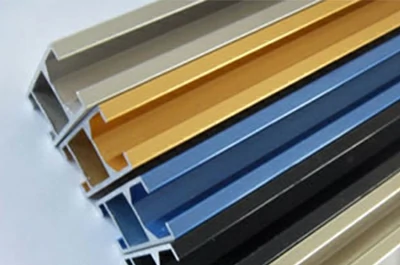 Anodizing
Anodizing- Improve aluminum surface durability with an oxide layer, providing diverse decorative colors and long-lasting color retention, albeit at a higher cost.
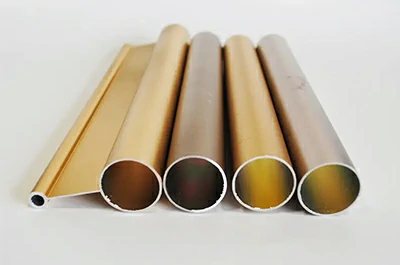 Electrophoresis paint
Electrophoresis paint- Ensure even coating on aluminum profiles through immersion and electric fields. It provides excellent weather, corrosion resistance, and decorative finish.
 Powder coating
Powder coating- Powder coating sprays aluminum profiles with powder, then cures them to form a durable finish. It provides wear, corrosion, and weather resistance in multiple colors.
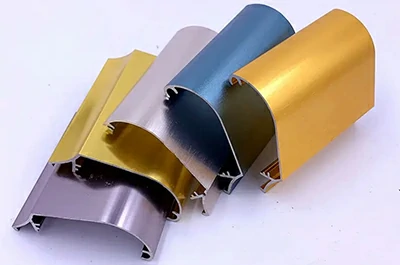 PVDF coating
PVDF coating- PVDF coating, from polyvinylidene fluoride resin, offers excellent weather and chemical resistance. Ideal for aluminum profiles requiring top weather durability and decorative finishes.
Aluminum profile production and processing
The aluminum extrusion process starts with a cylindrical aluminum billet, which is heated to temperatures between 400 and 500 degrees Celsius. The blank is then pressed through a mold with carefully designed contours. The mold shapes the aluminum into the desired cross-sectional shape, which can be as simple as a rectangle or as complex as a hollow tube with multiple interior chambers.
The extruded aluminum is then cooled by spraying water, which improves its mechanical properties and makes it easier to handle. During the cooling process, aluminum may undergo quenching to increase its strength and hardness.
Aluminum profile CNC machining
Aluminum extrusion CNC machining is the process of using computer-controlled machines to shape aluminum extrusion parts to a specific design. The process of CNC machining of aluminum extrusion consists of three main steps: design, programming and machining.
First, the design is created using computer-aided design (CAD) software, which can create precise dimensions and specifications. Next, the design is programmed into a CNC machine, which uses a series of tools to cut, shape and form the aluminum extrusion into the desired shape. Finally, the machined parts are usually finished by grinding, polishing or anodizing.
One of the main advantages of CNC machining of aluminum extrusion is the creation of complex shapes and models with high precision and consistency, suitable for parts that are difficult to manufacture using traditional methods. This process is highly automated, improves production efficiency and reduces labor costs. Another benefit is the versatility to produce parts in a variety of sizes and shapes to meet the needs of different industries.
Select MASTAR METAL
- Fast delivery: We have extensive inventory to ensure fast delivery of any standard aluminum profile, saving time for the smooth progress of your project.
- Customized profiles: In addition to standard aluminum profiles, M ASTAR can also provide customized aluminum profiles according to customer requirements for size and finish. You only need to indicate the alloy, length, quantity, surface finish, end use and other special requirements to us.
- High-Quality Products: The quality of our products complies with standards and certifications and features modern design, high hardness, bend resistance, rust resistance, and insect resistance, as well as good soundproofing and insulation properties.
- Competitive Price: Our product prices are competitive and we can provide reasonable discounts for large quantities, allowing you to get better prices and better services.
- After-sales support: We can provide fast after-sales support to ensure that you receive timely help and support when using our products.
